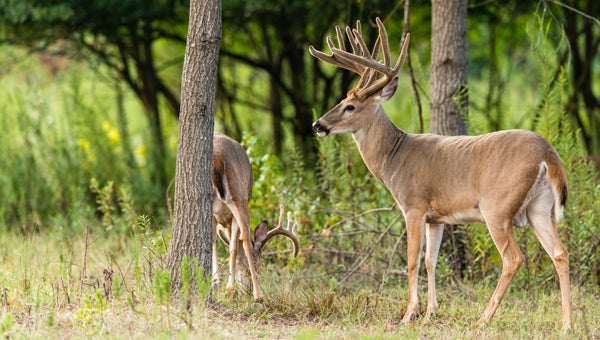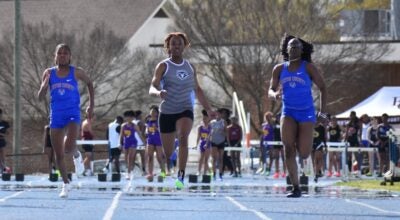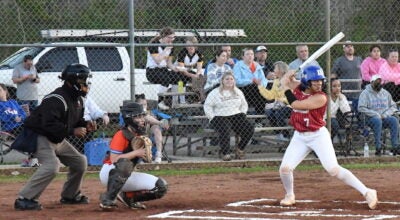Prepare for bow hunting season (outdoors column)
Published 4:33 pm Tuesday, October 6, 2015

Don’t smell: Scent and stand placement are important consideration when hunting big bucks like these, which were photographed in Chilton County. (Photo by Gary Mitchell)
By Gary Mitchell
Oct. 15 will bring the 2015-16 deer season in with bow hunting. Deer hunters from across Chilton County will make that first-day trek into their favorite spots in the woods.
According to weather forecasters, the first day of season should be in the 80s, but all should not despair. The late afternoon hours should still provide a decent time for a little stand sitting. With the days starting to get shorter, it’s harder for the heat to keep its grip an hour or so before dark. This allows for the hunter to have a chance to get out and participate in stand surveillance of the area.
Keep in mind, though, the wind direction and the placement of your stand. This will be critical if you want your stand to produce many days of enjoyment.
From my experience, if you are spotted sitting in a stand and a deer smells you at that point on, that stand will never seem to have the same impact. It will never produce as well as if they are never aware of your presence.
This was never truer than one time hunting here on my property in Chilton County. While hunting in a newly placed stand, I was spotted by an old doe that saw me before I saw her. In those days, I had just started bow hunting, and the does were fair game. She had come from a direction that I did not have much faith in. The trail signs did not give a tell-tale sign of any deer using this as a direction that they would come from.
By the time she arrived, she spotted me in the tree and fled the scene, blowing and alerting everything and everyone within miles that I was there.
The next time I sat in the same stand, another doe, possibly the same one, came out of another direction and was looking up at me as soon as she was in eyesight. Once again, she was stomping her feet as well as blowing as she ran right back in the same direction that she came.
Later that season, I sat in a shooting house there in the same field. I noticed that each and every time does and bucks would come in to the field; they would look up into the tree that the stand was in, inspecting it thoroughly before coming on in to the field. This was shocking to me because I had never seen or spooked a buck while in that stand.
I will say that by experience, they know, I cannot tell you how, but they know! Stand placement does makes a difference as well as wind direction. I will go further to say to never hunt in an open stand when the wind is swirling, as it does on really windy days. Nothing spooks a deer more than being unable to tell where a scent is coming from when they are trying to avoid danger.
The next thing is scent in your clothing as well as on your body. I once knew a guy who smoked all the time and had reasonable success at bow hunting. I never knew him to kill anything that was of any age, but he did take a few young deer.
For the most part, deer will not tolerate strange smells in the woods that they are not accustomed to smelling. To give an example, I have a feeding program that I have been on for some time. I feed a protein mix in the summer months, and in the winter turn toward a more carbohydrate-based feed for the deer.
Before the state’s approval of hunting season supplemental feeding, I would cease feeding before the season started and let them fend for themselves. After the approval, I continued feeding, following the rules of the state. This allowed me to continue attracting the does, which we all know will get the bucks sooner or later. I never felt any need to sit over piles of bait; just being able to know I could hold the does was enough.
There are two ways to attract bucks and two ways that bucks will tolerate human presence. That is their hunger and their need to breed.
One night, my girlfriend decided that she would like to go with me to fill my feeders and see if she would be lucky enough to get a glimpse at some deer. Well, she didn’t see any deer. The next time that I had gone to check the trail cameras, I noticed the deer had taken longer than normal to return to their normal feeding routines.
Normally, deer would be on the feeders within 30 minutes of me filling them after dark. This particular time, they did not return to the feeders until long after midnight. I waited a few weeks and asked her to ride with me once again, and the same thing happened again.
They say deer are creatures of habit, and I will agree. Let something happen in their environment, and it will change their behavior immediately.
Since leaving the deer woods as a hunter and returning as a photographer, I have been able to study deer habits much more than I did when I hunted. While hunting, I was waiting for the next big buck. Now, I was just paying attention to the body language, what they were doing and how they were interacting.
Wind is a huge factor to deer. When they can predict the direction that danger will come from, that is one story, but let the wind swirl and come from their “safe area” and it spells disaster!
If deer are accustomed to smelling something or someone, then they are fine. Introduce one new smell, and their comfort zone is blown.
This is simple to understand. Let’s look at the farmer on the tractor or on his farm. He always tells you stories of the deer he sees. The most important factor is that he has become commonplace in their lives.







